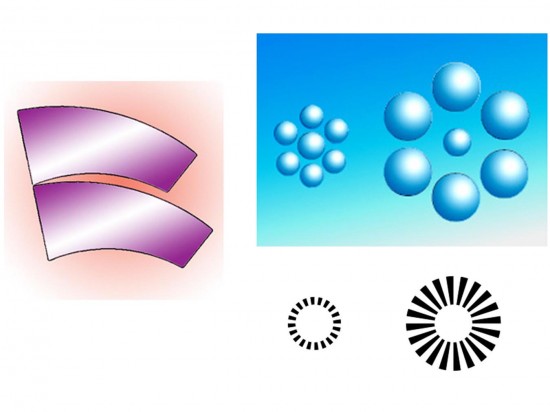I remember being baffled by the illusion to the left when I was a child. I think it was the first illusion I saw. The upper and lower blades are identical, but the lower one looks a lot larger. It’s called the Jastrow illusion, and it’s not surprising I was amazed by it, because it’s as puzzling today as it was when Jastrow first published it, over a hundred years ago. To the right are two versions of a similarly mysterious illusion, known either as Titchener’s Circles, (or sometimes as the Ebbinghaus Illusion). The central circles are objectively identical in size as seen to left and right, yet they look smaller when surrounded by the bigger circles and larger when surrounded by smaller circles.
Usually both illusions, Jastrow’s and Titchener’s, have been explained as the result of enhancement of contrasts in size. The key aspect of the Jastrow illusion, the theory goes, is the contrast between the long upper edge of the lower blade, and the short lower edge of the upper blade. The brain amplifies the size contrast between these edges, it is suggested, and the size of the whole figures gets adjusted in the process. The same kind of ramping up size contrast is proposed to explain the circles illusion, but this time it’s the contrast between the inner and outer circles. However, Jacques Ninio, from whose personal site I took the lower right figure, has a much more interesting suggestion …..
Ninio suggests that Titchener’s circles show an effect directly opposed to the one we see in Jastrow’s blades. With the circles, he proposes, it’s not enhancement of size contrasts between the central circles and the circles surrounding them, but on the contrary an illusory reduction in the real differences in size of the two whole assemblies of central-circle-plus-ring. So according to his proposal we see, for example, the whole figure with the ring of larger circles, upper right, as smaller than it is, and therefore the central ring in that figure looks reduced in size too.
So, according to Ninio, the two illusions, blades and circles, show us on the one hand the brain amplifying contrasts in size between adjacent figures, and on the other reducing differences in size across the field of view. Now that’s something like the way the brain does indeed deal with contrasts of light and dark, and of colour. I’m not aware that we have examples of the effect in everyday vision in relation to size, in the way that we do for tonal and colour contrast, but it’s an interesting idea.
Ninio’s site is not for the faint-hearted. But it’s packed with fascinatingly controversial observations from decades of speculation and research, and I’ll certainly be raiding it for ideas again.
If you enjoy such heavyweight discussions, try here, and here for research papers on the circles illusion. That last study is fascinating. It’s about whether or not, if we try to pick up the central circles in touchable versions of the illusion, our fingers misjudge the size of the circles just as our eyes do.

